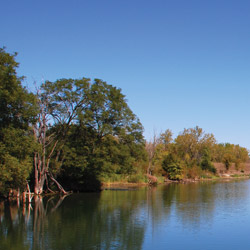Creating Benchmarks

The Illinois River and our scenic river valley have been attracting visitors since René-Robert Cavelier, Sieur de La Salle’s exploration in the late 1600s. In the centuries since, a visitor-based economy has taken root and flourished.
The Visitor-Based Economy Strategy Group of the Economic Development Council for Central Illinois is currently focused on the business impact of nature, cultural and heritage tourism in our region. Nature-based tourism includes anything that connects people with the outdoors, such as hunting, fishing, boating, canoeing, kayaking and watching wildlife. Cultural and heritage tourism attracts people to our festivals and fairs, historic homes, antique centers, restaurants and artisans. These types of tourists typically spend more during their visit than the average traveler.
The business development committee for the Illinois River Road National Scenic Byway pulls double-duty at the EDC’s Visitor-Based Economy Strategy Group. The Illinois River Road encompasses a 291-mile stretch on both sides of the Illinois River from Ottawa to Havana and 10 counties, including some of the most scenic views and educational nature waypoints in the state. It travels through dozens of quaint and culturally-gifted communities and hundreds of interesting and original attractions, with the City of Peoria as the central point.
Recently, the Illinois River Road received grant funds from the National Scenic Byways Program through the EDC’s Strategy Group/EDGE (Economic Development and Growth Experts) program. This grant will benefit the Illinois River Road byway traveler by supporting program developments that will directly enhance their experience.
According to Byway Director Anaise Berry, “An easy and meaningful travel experience will be achieved by interpreting the Byway’s primary intrinsic quality of nature for the visitor at waypoint sites, through navigational signage and Byway-educated site managers and community members.”
The Visitor-Based Economy Strategy Group is focused on a portion of the grant-funded project that will produce a comprehensive inventory of Byway-related support facilities and infrastructure that enhances visitors’ experience. Action items include:
- Refine criteria for the inventory and evaluation of Byway-related support businesses. Examples of such enterprises include bike rentals, guide services and educational programming furnished by nonprofit and for-profit partners.
- Conduct an infrastructure inventory in the Byway region using agreed-upon criteria and review findings in community meetings.
- Document findings, including gaps in product offerings.
- Prepare recommendations for ways to address gaps, including existing related business expansion to meet anticipated needs and possible new business development, recruiting and relocation.
- Cultivate authentic businesses to enhance intrinsic value to visitor experience.
- Assemble listing of sources of funding to support new business expansion or development to meet identified needs.
- Create an outreach strategy for recruiting or expanding businesses and identification of funding opportunities.
- Develop related communications materials and website as appropriate.
- Prepare case studies from other experiential tourism regions in the U.S. where gap analysis and infrastructure development have been successful.
- Identify success factors that could be used in the Illinois River region. Possible proficiencies to consider: leadership, innovation, knowledge sharing, collaboration/partnership, access to capital, policy support and authenticity.
“Having more authentic businesses on and near the Byway will create a more worthwhile and meaningful experience for travelers,” said Terry Svob, chairman of the Visitor-Based Economy Strategy Group. “Nature tourists are a significant target market, and Byway travelers seek authentic experiences when traveling. That includes being able to participate in activities that connect them with the outdoors (such as canoeing, boating and biking), as well as being able to make authentic purchases that connect them to the Illinois River Road.
“Authentic experiences, such as dining in unique, locally-owned restaurants, purchasing wares that are locally produced and sold, and taking part in activities that are unique to the Byway region are all very important to creating a memorable and meaningful travel experience,” he continued. “A canoeing outfitter that provides the traveler with what is needed to experience life on the water for a couple hours; the potter or glassblower that creates a piece of art before a traveler’s eyes; the restaurateur who prepares that special meal and friendly, hometown service to go along with it—those are just a few of the types of businesses necessary throughout the Byway region to create that authentic experience for Byway travelers.”
The research proposed in this request will enable Byway communities to take action to enhance the Byway traveler’s experience, while helping to grow and strengthen the communities’ economies at the same time. “This inventory of Illinois River Road National Scenic Byway-based businesses will give the EDC the necessary benchmarks to measure the economic impact of the Byway program and visitor-based tourism in our region,” added Vickie Clark, COO of the Economic Development Council for Central Illinois. iBi

